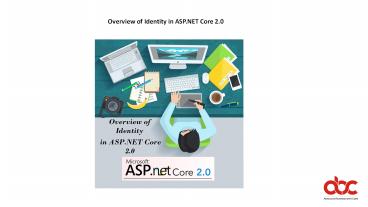Overview of Identity in ASP.NET Core 2.0 - PowerPoint PPT Presentation
Title:
Overview of Identity in ASP.NET Core 2.0
Description:
ASP.NET Core Identity, a membership system, or login provider, is used by Dot Net apps to access login functions. – PowerPoint PPT presentation
Number of Views:174
Title: Overview of Identity in ASP.NET Core 2.0
1
Overview of Identity in ASP.NET Core 2.0
2
Introduction
- ASP.NET Core Identity, a membership system, or
login provider, is used by Dot Net apps to access
login functions. - Whenever we install an application, we know that
almost all applications ask our identification
this login information (confidential information)
is stored in the identity racks of application. - And nowadays due to access use of social media
accounts (Facebook, Twitter, Microsoft, and
Google), some apps make use of external login
providers, that make use of OAuth or OpenID.
Names, passwords, phone numbers, addresses are
stored in the persistent layer database such as
MS-SQL by performing basic steps of configuration
or the use of Tokens are done to just
authenticate and authorize them. - Besides this, other objectives of using identity
in ASP.NET Core 2.0 are as follows.
3
The Need and Purpose of Identity in ASP.NET Apps
- Authentication of users before giving them
complete access. - Registration of new users.
- authorization of users data
- Security policy implementation such as Renewal of
passwords or resetting identification in case of
forgetting the old one. - Rich set management services and cookie
configuration. - Maintaining the user profile, data, and other
personal information.
4
1 Importance of Identity for Security
- With in-built Identity library in ASP.NET,
developers can maintain the security of their
application. - The identity parameter enables programmers to
store insightful secrets of coding, these
parameters separate the confidential information
from the coding context and thus security is
maintained. - Furthermore, apps can also overcome vulnerability
attacks and security breaches.
2 Using ASP.NET Core Identity Model
- The big picture of using the identity model
entails EF core model, an entity framework model,
which has various entities for representing a
user, a role, claiming process, authentication
token for the user, creates a relationship
between user and login, granting multiple claims
and establishing join entities as presented by
Microsoft documentation.
5
3 The Architecture Model of ASP.NET Core 2.0
Identity
- The default architecture of ASP.NET Core
primarily consists of two classes - The managers are also named as a high-level
class, used by developers to create identities or
other higher operations. Moreover, these
operations are not associated with lower classes. - The low-level classes interact with the data
access layer and pursue the repository pattern.
6
4 Customized Model for Application
- On top of that, ASP.NET Core Identity
architecture is a large system that gives
customization. - Customize architecture carries different
templates, interfaces, styles for developing
applications. For example, when you prefer
different database template (i.e. Dapper or Azure
table storage) for your project, the default
architecture doesnt work for you. - But thanks to custom storage providers, which
helps to do writing, editing, and creation of
customized provider and then also provide a
plug-in tool. - Hope this short article explains the Identity in
ASP.NET Core 2.0 version. Check out Ansibytecode
website and learn a range of technologies with us.
7
Email us
Call us info_at_ansibytecode.
com 91 (989)
8010 589 India - D-203, 2nd Floor, Ganesh
Meridian, S.G.Highway, Ahmedabad 54































